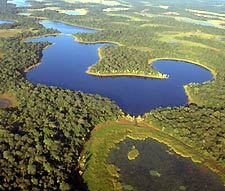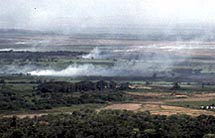|
 In January 1999, two of the United States' major
forces in wildlife conservation - Ducks Unlimited and the Forest
Service - signed an agreement to expand their cooperative work
beyond their home country's borders. In January 1999, two of the United States' major
forces in wildlife conservation - Ducks Unlimited and the Forest
Service - signed an agreement to expand their cooperative work
beyond their home country's borders.
Together, with other
organizations such as the U.S. Fish and Wildlife Service, the U.S.
State Department, The Nature Conservancy, and many others, they are
collaborating and sharing information with conservationists from
around the world. This work builds on the solid success from ongoing
partnerships such as the Western Boreal Forest Initiative and the
RESERVA continuing education program for conservation professionals
in Mexico and Latin America.
Increasing our Understanding
of the World's Largest Freshwater Wetland
The extensive
floodplain of the Paraguay River stretches out across the borders of
Brazil, Bolivia, and Paraguay to form the Pantanal. This area covers
over 37 million acres, of which 27 million are wetlands making it
the world's largest continuous freshwater wetland. The Pantanal
provides habitat for over 600 bird species and 260 fish species.
Part of this huge area is preserved. However, much of the
region is unprotected and proposed for development. Clearing of
land, cattle, mining, power plant construction, indiscriminate
tourism, hunting, gas and oil pipelines, channelization for barge
navigation, and road building are threatening this rich and unique
ecosystem.
The governments of Bolivia, Brazil, and Paraguay
are working together to conserve the natural resources of the
Pantanal and make decisions on the development of the area. They
have requested that Ducks Unlimited, The Nature Conservancy, and the
Forest Service work with the government agencies, universities, and
local non-governmental organizations to establish a comprehensive
natural resource database for the entire Pantanal watershed.
Specifically, the Forest Service Office of
International Programs and The Nature Conservancy are
collaborating with local partners to complete an eco-regional
assessment outlining management options for watershed protection,
conservation of biological diversity, and sustainable resource use.
Concurrently, Ducks Unlimited and the Forest Service are developing
a GIS database to manage several existing data types in a common
format that will be accessible and practicable for use by multiple
groups and organizations.
The Ramsar Convention on Wetlands - COP7
In May 1999,
San Josť, Costa Rica graciously hosted the seventh Conference of the
Contracting Parties to the Convention on Wetlands - COP7 (The Ramsar
Convention). The USDA Forest Service, along with the U. S.
Department of State, U. S. Fish and Wildlife Service, Environmental
Protection Agency, International Association of Fish and Wildlife
Agencies, and the Terrene Institute participated in this conference
as part of the official U. S. Delegation.
COP7 provided the
perfect audience for the Forest Service and Ducks Unlimited to
demonstrate the many uses of Geographic Information Systems (GIS) in
managing and protecting important wetland systems. Much of the
presentation came from hands-on experience working with wetlands in
North America.
Specifically, the successful partnership work
from the Copper River Delta on the Chugach National Forest (Alaska)
provided a positive example of information gained from GIS leading
to better management decisions. This workshop had the highest
attendance of any of the COP7 technical workshops, stimulating many
discussions and launching new and exciting partnerships among many
in attendance.
|
In 1971, the city of Ramsar, Iran hosted the meeting where
the text of the Convention on Wetlands was approved. This
meeting facilitated the signing of an intergovernmental treaty
providing the framework for national action and international
cooperation for the conservation and wise use of wetlands and
their resources.
Since that time, the Convention on
Wetlands has been known as the Ramsar Convention. The Ramsar Convention
was the first treaty to adopt an ecosystem approach addressing
wetlands. It is a forum providing support to governments in
their pursuit of wetland conservation.
However, it is
not a regulatory agency, nor does it presume to impose any
restrictions or conditions that affect the sovereignty of its
member countries. There are presently 119 Contracting Parties
to the Convention. The United States became a contracting
party in April 1987, under the signature of President Ronald
Reagan. |
 Partners to Restore Nariva
Swamp Partners to Restore Nariva
Swamp
The twin-island Republic of Trinidad and
Tobago joined the Ramsar Convention in 1993 and designated
Nariva Swamp as its first "Wetland of
International Importance." Historically, Nariva provided diverse
habitat for numerous species, including many birds migrating from
the United States and Canada.
As a result of illegal
activities such as clearing, burning, and draining the wetland, the
Government of Trinidad and Tobago formally requested that Nariva be
included in the "Montreux Record." The Montreux
Record is a register of Ramsar sites where adverse changes in
ecological character have occurred, are occurring, or are likely to
occur as a result of technological developments, pollution or other
human interference.
This designation allowed a special
Ramsar technical mission to work with the governmental agencies,
local citizens and groups, and non-governmental organizations to
analyze the situation and prepare recommendations for action. The
Trinidad and Tobago government began to take action on these
recommendations by removing the unauthorized farming
operations.
During the Ramsar COP7, the delegation from
Trinidad and Tobago requested that the Forest Service and Ducks
Unlimited visit Nariva and begin a partnership for developing work
plans in response to the recommendations from the Ramsar mission.
The partners, in concert, have now developed plans to address
wildfires, the need for appropriate prescribed fire, restoring
wetland hydrology, and managing aquatic and forest vegetation.
Collaboration continues as the partners await the next dry season to
implement these plans. To learn more about DU's Latin America and
Caribbean program click
here.
|







 In January 1999, two of the United States' major
forces in wildlife conservation - Ducks Unlimited and the Forest
Service - signed an agreement to expand their cooperative work
beyond their home country's borders.
In January 1999, two of the United States' major
forces in wildlife conservation - Ducks Unlimited and the Forest
Service - signed an agreement to expand their cooperative work
beyond their home country's borders.  Partners to Restore Nariva
Swamp
Partners to Restore Nariva
Swamp
